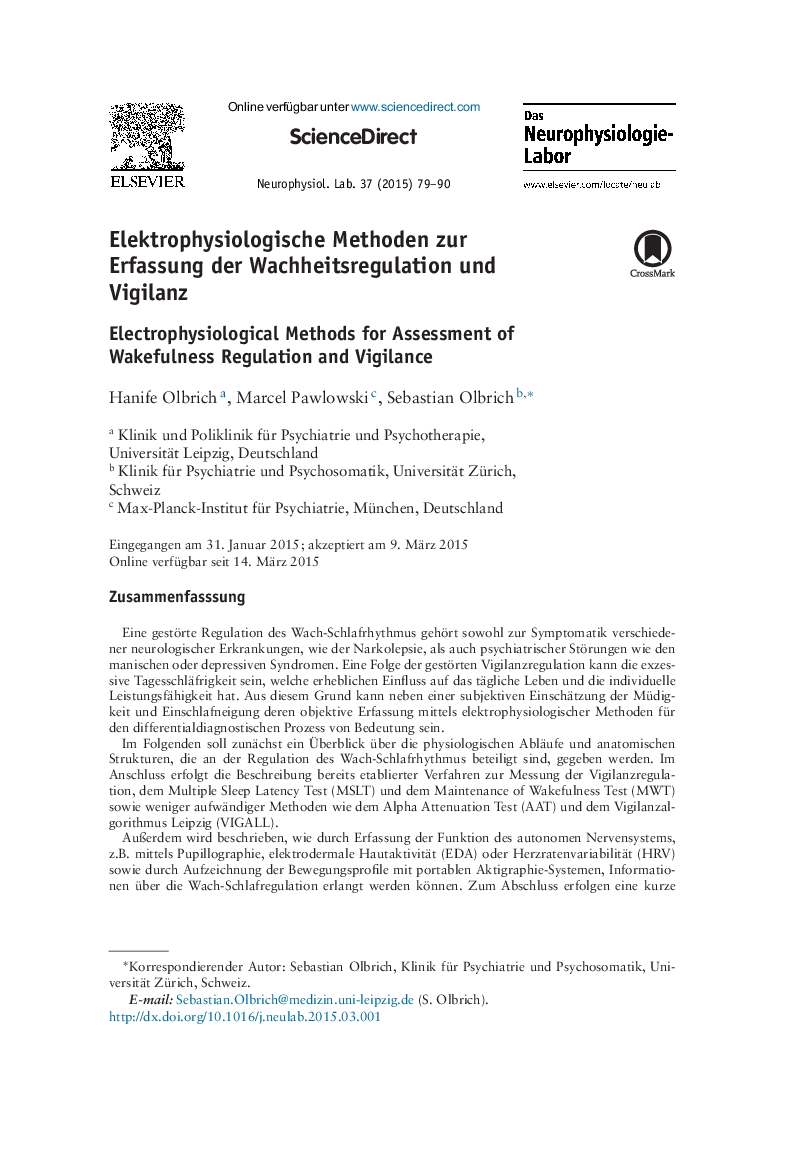| Article ID | Journal | Published Year | Pages | File Type |
|---|---|---|---|---|
| 2684820 | Das Neurophysiologie-Labor | 2015 | 12 Pages |
ZusammenfasssungEine gestörte Regulation des Wach-Schlafrhythmus gehört sowohl zur Symptomatik verschiedener neurologischer Erkrankungen, wie der Narkolepsie, als auch psychiatrischer Störungen wie den manischen oder depressiven Syndromen. Eine Folge der gestörten Vigilanzregulation kann die exzessive Tagesschläfrigkeit sein, welche erheblichen Einfluss auf das tägliche Leben und die individuelle Leistungsfähigkeit hat. Aus diesem Grund kann neben einer subjektiven Einschätzung der Müdigkeit und Einschlafneigung deren objektive Erfassung mittels elektrophysiologischer Methoden für den differentialdiagnostischen Prozess von Bedeutung sein.Im Folgenden soll zunächst ein Überblick über die physiologischen Abläufe und anatomischen Strukturen, die an der Regulation des Wach-Schlafrhythmus beteiligt sind, gegeben werden. Im Anschluss erfolgt die Beschreibung bereits etablierter Verfahren zur Messung der Vigilanzregulation, dem Multiple Sleep Latency Test (MSLT) und dem Maintenance of Wakefulness Test (MWT) sowie weniger aufwändiger Methoden wie dem Alpha Attenuation Test (AAT) und dem Vigilanzalgorithmus Leipzig (VIGALL).Außerdem wird beschrieben, wie durch Erfassung der Funktion des autonomen Nervensystems, z.B. mittels Pupillographie, elektrodermale Hautaktivität (EDA) oder Herzratenvariabilität (HRV) sowie durch Aufzeichnung der Bewegungsprofile mit portablen Aktigraphie-Systemen, Informationen über die Wach-Schlafregulation erlangt werden können. Zum Abschluss erfolgen eine kurze Bewertung der beschriebenen Methoden und eine Einschätzung der Relevanz für die klinische Diagnostik.
SummaryPathological alterations of wake-sleep regulation are part of the symptomatology of several neurological disorders such as narcolepsy and psychiatric diseases such as manic or depressive syndromes. As a consequence of disrupted wake-sleep regulation, excessive daytime sleepiness can impact daily life and the individual capability. Besides subjective estimates of sleepiness and sleep propensity, an objective assessment of these parameters by electrophysiological methods might be of value for differential diagnosis.At first a brief overview is given on the physiological processes and anatomical structures that underlie the regulation of wake and sleep. This is followed by a description of already established clinical tools for assessment of wake-sleep regulation, namely the Multiple Sleep Latency Test (MSLT) and the Maintenance of Wakefulness Test (MWT) and less effortful and costly methods such as the Alpha Attenuation Test (AAT) and the Vigilance Algorithm Leipzig (VIGALL).Further, the analysis of vigilance regulation by assessing the function of the autonomous nervous system will be discussed, comprising the pupillography, electrodermal activity (EDA) and heart rate variability (HRV). Also a short introduction into actigraphy and the assessment of sleep-wake profiles using movement parameters will be given. This is followed by a short evaluation of the value of the different methods and their clinical usability.
